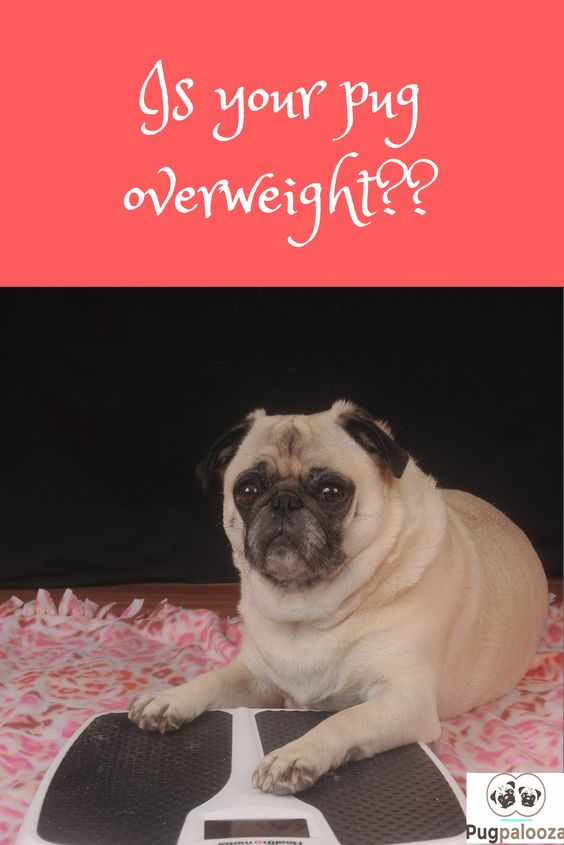Half of all pets are overweight
Just recently, on October 11th, 2017, we celebrated Pet Obesity Awareness Day… BUT… is it REALLY a celebration? The news on that day told us that over half of all dogs and cats are overweight or obese. That’s a total of 36.7 million dogs and 43.2 million cats that need to lose a few pounds.
Are my girls (Molly and Dolly) one of these statistics? Yep!! They both need to lose about 4 pounds to be at their optimum weight.
Most people believe that their pets are healthy and at a comfortable weight and are surprised when their vet tells them that their pet is overweight. I am one of these people. I think my pugs look very healthy so I was in denial about their weight.
Excess weight is dangerous
After talking to my vet, I decided I better take a second look and try to get my pugs to lose a few pounds. According to my vet, excess weight and obesity is just as dangerous for our pets as it is for us. When dogs carry around excess weight, it puts a strain on their bones and joints and it can restrict their movements. If your pet (pug) has breathing problems, the extra weight can put a strain on their breathing and can lead to serious illnesses like diabetes.
Canine obesity is one of the fastest growing health problems seen in dogs today.
These diseases and disorders could be caused by obesity:
*Cardiac arrest
*Diabetes
*Hypertension (high blood pressure)
*Cancer
*Respiratory disorders
*Osteoarthritis
Or
*Orthopedic injuries
According to one vet, “The solution is pretty simple: To avoid weight gain, calories burned must be equal or greater than calories ingested.”
Why are our dog’s overweight?
There are many different reasons why your dog might be gaining weight. The two most common reasons are improper diet and not enough exercise. Another reason a dog might gain weight is that they are recovering from an illness or a surgery and can’t exercise. Weight gain can also be a symptom of some type of hormonal disorder (ex: hypothyroidism or Cushing’s syndrome). Genetics are a huge factor in obesity too. Certain types of dogs are just prone to weight gain- dogs like Pugs, Dachshunds, Dalmatians, English Bulldogs, Beagles, and Cocker Spaniels.
Strenuous exercise not for pugs
Pugs are one type of dog that is not designed for strenuous exercise so that makes it tough to keep them at their optimum weight. Not enough exercise combined with the fact that pugs get lots of affection and treats = weight gain. Pugs do not need to run or walk three miles a day, but they DO need to get some exercise everyday. My pugs (Molly and Dolly) and I walk about a mile everyday. We don’t walk real fast- I let my girls smell what they want, roll in the grass, etc… A little bit of exercise everyday will help keep their weight down, strengthen their joints and it’s good for their heart and lungs.

Sometimes, weight gain sneaks up on you (that’s what happened to my girls). Your dog might gain a few pounds gradually and you don’t really notice. If a friend or family member makes a comment about your dog gaining weight, PAY ATTENTION!! If your dog doesn’t act like they want to go for a walk or they have suddenly become lazier than normal, it may be because of weight gain.
There are some things you can do at home to evaluate your dog’s weight:
–Run your hands along your dog’s ribcage. You should be able to feel his/her ribs- if you can’t feel the ribs, your dog is probably carrying excess weight.
–Look at your dog from the side view. You should be able to see the upward tuck of their abdomen. If you can’t see this, it’s probably a sign of your dog being overweight.
–You can also view your dog from above. Your dog should have a slightly narrowing at their waist, just past the ribcage. A straight or bulging line from the ribcage to the hips is a sign of an overweight dog.
I found this on the Internet and thought it was interesting, so thought I would share:
Calorie Requirements:
How many calories does a pug puppy need?
Roughly 50 calories per pound of body weight; though this can vary up or down by 30% depending on activity level, health and individual metabolism.
How many calories does an adult Pug dog need?
Once a pug has reached his/her adult size- both height and weight- he will need approximately 40 calories for each pound of body weight to maintain. This can vary by up to 30% depending on his activity level, health and individual metabolism. (Senior pugs will have a gradual slowing down of metabolism and that is usually accompanied by less activity. For this reason, older senior pugs will need less to maintain.
If your dog is overweight or just needs to lose a few pounds (like mine) or you want to have a plan to maintain their healthy weight, talk to your vet- They will help you develop a weight management program that consists of a strict diet and exercise plan. Your vet will also monitor your dog’s weight whenever you go for a check-up to be sure they are staying at a healthy weight.
Be sure you take your dog to the vet every 6-12 months for a wellness check-up.
Here’s a link to a wonderful book that tells about a lady that used some creative techniques for saving her dog from obesity… I think you’ll like it!!
Until next time,
Love and Pug Kisses,
Candy
